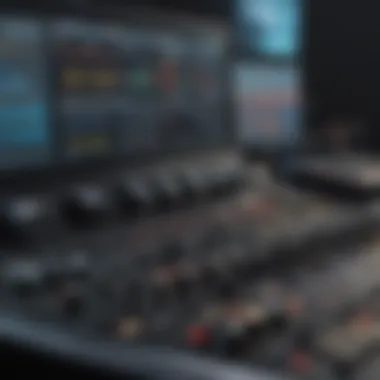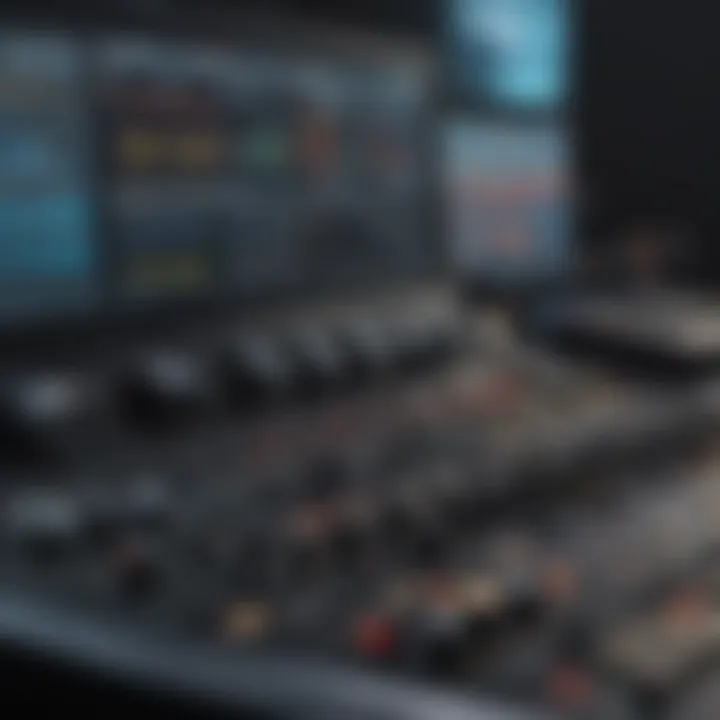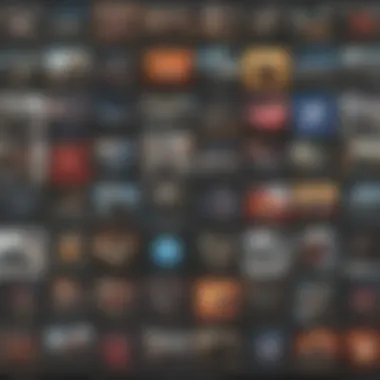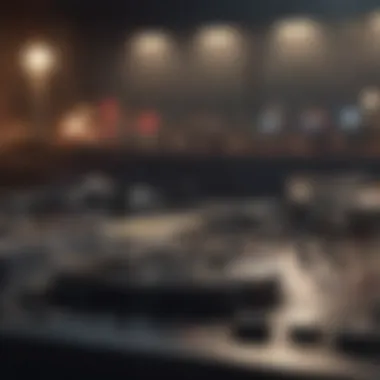Exploring the Art of Remixing Music Online


Intro
In the digital age, the sound of music has morphed into something dynamic and fluid. Remixing is more than just a practice; it has become a culture, fueling creativity and collaboration among artists and producers worldwide. The blend of various genres, samples, and styles allows aspiring musicians and seasoned artists alike to reimagine and reinvent existing works. This article will take a closer look at the layers of remix culture, focusing on the tools, platforms, and legalities that shape this vibrant artistic landscape.
Artist Profile
In the realm of remix music, understanding the artists behind the sounds gives us a deeper insight into the culture's fabric. While we won't focus on one artist, instead, we will explore the diverse influences that shape this ever-evolving genre.
Biography and Background
Many remix artists come from varied backgrounds, often stepping into the scene from entirely different music genres. They may start in local bands, DJing at nightlife events, or even producing their own content at home. This diversity creates a melting pot of styles, where EDM, hip-hop, pop, and experimental music collide.
Major Influences and Inspirations
Influences are as varied as the artists themselves. Some draw inspiration from the classic sounds of the past, like funk or disco, while others lean towards contemporary trends. Here are a few notable influences:
- Hip-Hop: The roots of remix culture often stem from hip-hop, where sampling tracks is a cornerstone of creativity.
- Electronic Music: Artists like Daft Punk and The Chemical Brothers continue to inspire new generations with their innovative techniques.
- Pop Culture: Modern artists often remix not just songs, but also cultural phenomena, weaving together snippets from films or viral media to create a broader narrative.
Song Analysis
When examining remix tracks, it can be illuminating to dissect the songs at a granular level.
Theme and Lyrics Breakdown
Many remixes retain the foundational lyrics of the original but reinterpret them to fit a new context. The themes often range from love and heartbreak to social issues and celebration. Analyzing how these themes are reshaped can reveal much about current cultural moments and artistic intentions.
Instrumentation and Composition
The instrumentation in a remix can vary drastically. Producers often add new layers, or completely revamp the underlying beat. Techniques like chopping, looping, and pitch-shifting can introduce fresh elements that breathe new life into familiar tunes. A look at these elements can uncover the artistry behind remixes:
- Sampling: Utilizing snippets from the original track can create nostalgia while bringing a fresh spin to the sound.
- Looping: By repeating certain beats or sections, the remix can build an infectious rhythm that keeps listeners engaged.
- New Elements: Introducing synthesizers, drums, or even live instruments can enhance the overall composition, ensuring that the remix stands apart from the original.
"Remixing is akin to storytelling; it’s about taking what is known and creating the unexpected."
Epilogue
As we navigate the complexities of remix music online, one thing is abundantly clear: this vibrant, ever-changing culture is a showcase of creativity and innovation. By understanding the artists' backgrounds and analyzing the intricacies of songs, we gain remarkable insights into the digital soundscape molding our music today. The conversation around remixing and its implications in the industry continues to evolve, yet one thing remains certain—the music will keep playing.
Understanding Remix Culture
In today's music landscape, the concept of remixing stands as a cornerstone of creativity and innovation. This section aims to unravel the importance of remix culture, shedding light on specific elements that make it vital in both historical and modern contexts. Understanding remix culture helps artists and enthusiasts appreciate the rich interplay between original works and their reinterpretations. It opens avenues for collaborative art, pushing the boundaries of what music can be.
Historical Context of Remixing
To grasp the essence of remixing, it's essential to look back in time. The act of remixing wasn’t born with the digital age; it has roots extending to the disco era of the 1970s. Early DJs, such as Francis Grasso and David Mancuso, laid the groundwork by mixing tracks live, seamlessly blending different tunes to keep the party going. This kind of spontaneous creativity was a precursor to the sophisticated remixing tools we use today.
Fast forward, and the rise of technology brought forth new platforms for remixing. The introduction of software like GarageBand and Ableton Live allowed musicians, both seasoned and novice, to manipulate audio in ways that were previously unimaginable. This evolution has transformed how we engage with music, giving rise to genres that emerged directly from remix culture, such as trip-hop and mashups. With each decade, artists started recognizing the power of samples as not just borrowed sound, but as an new medium for creativity.
The Evolution of Remixing in Music
Remixing has evolved not just in technique but also in its perception and acceptance. Initially, remixes were often viewed as inferior versions of the original track, an afterthought rather than an art form. However, notable remixes like Timbaland's reimaginings of Aaliyah songs in the late '90s radically shifted perspectives. They showcased that remixes could stand on their own and even surpass the original.
In recent years, remixing has morphed into a form of expression, where artists pay homage to their influences while crafting something entirely new. Collaborations between popular artists and DJs are now common; they blend genres and styles, resulting in tracks that often dominate the charts. The emergence of social media has amplified this phenomenon—remixes can be produced, shared, and celebrated on platforms like SoundCloud and YouTube, where accessibility fuels the creative process.
Cultural Significance of Remixes
Remixes hold a profound cultural significance. They are not merely alterations of existing works but reflections of contemporary society, capturing the zeitgeist of their times. A remix can revive an old hit, breathing new life into it, thereby connecting generations of listeners. Artists such as DJ Khaled or Diplo often leverage their status to blend different cultural sounds, illustrating how remixing fosters cross-cultural conversations.
Moreover, remixes often challenge the norms within the music industry. They stir discussions around originality, ownership, and artistic intent. This dialogue empowers aspiring musicians to carve their own paths. As stated by the famous producer Mark Ronson, "Remixing is an art of taking something you love and twisting it into something new, a conversation between the past and the present."


In summary, understanding remix culture is pivotal for music enthusiasts and creators alike. It encompasses a rich tapestry interwoven with history, evolution, and cultural significance, offering insights into how music continues to resonate across boundaries.
Key Components of Remixing
Remixing music is a nuanced art form that takes the creative spark of an original piece and transforms it into something novel and unique. Understanding the key components involved in remixing gives both budding producers and seasoned musicians a clearer view of the landscape they traverse. Each element plays a pivotal role in shaping the final output, and when they align, they can lead to outstanding musical creations. Here’s a closer look at these foundational aspects that can make or break a remix.
Understanding the Source Material
When diving into a remix, the source material is your compass, guiding you through the sonic seas. Whether it’s a catchy pop track, a deep house banger, or an indie rock gem, knowing the ins and outs of the original song is essential. This means not just listening to the track, but dissecting it like a surgeon with a scalpel.
You want to pick apart its structure, its chord progressions, and maybe even its lyrical themes. Ask yourself, what makes this original work stand out? What emotions does it evoke? This understanding informs your choices about which elements to preserve and which to reinvent. The goal is to create a fresh take while respecting the essence of the original.
In remixing, it’s not uncommon to utilize samples—snippets of sound that can deliver an extra punch. Knowing how to harness these bits effectively can elevate a remix from mediocre to marvelous. It's imperative to keep an ear attuned to how different versions of the same track can build off of one another without losing sight of creative integrity.
Creative Techniques in Remixing
Once you’ve honed in on your source material, it's time to pull out your creative toolbox. There’s a myriad of techniques you can employ to give your remix its own flavor. Some of these methods include:
- Rearrangement: Shake things up by altering the order of verses, choruses, or bridges. This can lend a surprising new flow to a familiar song.
- Pitch Shifting: Altering the pitch can make vocals sound ethereal or introduce different emotions. Similarly, changing the tempo can transform a ballad into a dance track with just a few tweaks.
- Layering: Combining multiple elements provides depth and texture. For example, adding a groovy bass line to a pop remix creates a catchy dance vibe—think Justin Bieber's “Sorry” remixed into a house anthem.
- Adding Effects: Embrace the tools at your disposal. Reverb, delay, and modulation can breathe new life into vocals and instruments, allowing you to craft a sonic landscape that feels unique.
Creative techniques are not limited to the audio engineering side. It’s also about your artistic intuition and conceptual vision for the track. Don’t shy away from experimentation; trial and error can lead to delightful surprises.
Genre Blending and Its Impact
Now let’s talk about one of the more magic aspects of remixing—genre blending. This is where true innovation happens. By pulling influences from varied genres, remixers can create hybrid tracks that resonate within different music circles. Take, for example, the fusion of hip-hop and EDM; tracks such as Lil Nas X’s “Old Town Road” exemplify how mixing styles can reach broader audiences.
The beauty of genre blending is that it opens up possibilities for collaboration. Artists can pull listeners in from diverse backgrounds, creating a melting pot of sounds. However, it also comes with its challenges. Some purists may not take kindly to what they perceive as a dilution of their beloved genre. That said, the push and pull of artistic friction often leads to exciting new possibilities.
In essence, mastering the blend of genres can be a game-changer, attracting new listeners and creating a fresh path through the cluttered landscape of modern music.
"In the world of remixing, creativity is the only currency worth spending. Those who dare to innovate will forge paths others can only dream of."
Whether you're standing on the shoulders of giants or dancing in unexplored territory, embracing these key components will equip you for the thrilling journey of remixing music online.
Platforms for Online Remixing
Platforms for online remixing play a crucial role in the evolution of music creation today. They empower both seasoned pros and enthusiastic beginners to engage in the art of remixing effortlessly. In a world where collaboration knows no borders, these platforms also open up a significant avenue for creativity, enabling users to share their uniqueTake on existing tracks. Having access to a robust selection of tools can elevate the remixing process, bringing fresh perspectives into music that might otherwise remain stagnant.
Popular Remixing Software
When it comes to music remixing, the software you choose can make all the difference. Programs like Ableton Live and FL Studio are household names, especially among electronic music producers. Ableton Live, for instance, provides a powerful suite of features designed specifically for live performances and studio work, backing versatility with user-friendly navigation. On the other hand, FL Studio shines with its pattern-based approach, allowing for quick ideas that can turn into full tracks in no time.
While these are popular choices, other software options can cater to various skill levels and musical styles. Software like GarageBand suits newcomers with its intuitive interface but still offers professional tools for those looking to advance. Other notable mentions include Pro Tools for high-grade studio work and Logic Pro X, known for its extensive library of sounds — perfect for remixing and composition.
Online Tools for Aspiring Producers
Aspiring producers today have a wealth of online tools at their fingertips, many of which don’t require significant financial investment. Websites like BandLab and Soundtrap offer cloud-based platforms where users can collaborate in real-time, a feature which is quite revolutionary in the remixing world. You can mix and match sounds, throw down your own samples, and even invite others to add their touches.
Additionally, platforms such as Splice provide access to an enormous library of samples and loops, making it easier than ever to layer your sound. With just a few clicks, you can find the perfect sound that matches your vision. Online tutorials are abundant on sites like YouTube, where expert creators share their skills, guiding you from beginner to advanced techniques without having to leave your home.
Social Platforms for Sharing Remixes
Once the remix is crafted, sharing it is the next big step. Social platforms have become essential in cultivating a community of music lovers and creators. Sites like SoundCloud offer a space to upload and showcase your remixes, while also enabling feedback and critique from listeners around the globe.
You can also tap into the vast user base of platforms like Reddit, where subreddits are dedicated to specific genres and remixing discussions. Facebook groups provide a more intimate setting for sharing work, allowing for interaction among like-minded individuals and encouraging collaborative efforts.
Remixes have the potential to go viral, reaching audiences far and wide, but it all begins with using these platforms effectively.
Collaboration and feedback are the cornerstones of remix culture. By sharing your work, you take a crucial step towards connecting with fellow creators, expanding your understanding, and reaching your audience.
The Role of Technology in Remixing


Technology plays a pivotal role in the world of music remixing. It serves not just as a tool, but as a catalyst that propels creativity and innovation in this vibrant realm. As the digital landscape continues to expand, artists are finding themselves equipped with more robust tools than ever before. The seamless merging of creativity and technology not only enriches the remixing process but also paves the way for fresh sounds and styles that challenge our traditional understanding of music.
One of the most significant benefits of technology in remixing is accessibility. Gone are the days when intricate software and high-end equipment were reserved for professional studios. Now, aspiring musicians can harness the power of their home computers or even smartphones to create and share their remixes. This democratization of music production encourages a diverse range of voices and ideas, ultimately leading to a more vibrant musical landscape.
Another consideration is how technology facilitates collaboration. Online platforms allow artists from different corners of the globe to work together, melding various influences and styles that can only enrich their remixing efforts. Through platforms that enable real-time collaboration, remote friendships can evolve into creative partnerships. Technology, therefore, does not simply enhance individual creativity; it breeds community and collective expression, adding layers of complexity to the remixing process.
Digital Audio Workstations (DAWs)
Digital Audio Workstations, commonly known as DAWs, are at the heart of today’s remixing scene. These sophisticated software applications enable users to record, edit, and produce music using virtual tools and samples. An example of a popular DAW is Ableton Live, which has become a favorite among aspiring and established remix artists alike.
DAWs provide a user-friendly interface that allows for the manipulation of audio. Users can craft their creations with features like MIDI sequencing, audio recording, and an array of plugins to enhance sound. The learning curve may seem steep at first, but once artists dive into it, they often find a world of creativity awaiting them.
Some key features of prominent DAWs include:
- Multi-track recording: Allows for layering sounds, vocals, and instruments.
- VST plugins: These are virtual instruments and effects that expand the sonic palette available.
- Automation: Users can adjust parameters over time, creating a dynamic and evolving sound.
DAWs have shifted the paradigm of how remixes are produced, offering a level of customization and finesse that was previously unattainable by the average musician.
Artificial Intelligence and Music Remixing
Artificial Intelligence (AI) is gradually becoming a game-changer in the music industry, including the domain of remixing. AI algorithms are now capable of analyzing songs, identifying key elements, and even generating new music based on existing tracks. This technological advancement opens up a plethora of possibilities for remix artists.
For instance, an AI could suggest chord progressions or drum patterns that complement the original material. Moreover, some platforms incorporate AI to get suggestions for perfect sample matching or even to create unique loops tailored to a specific vibe a producer is aiming to capture. Such tools reduce the time and effort required, allowing artists to spend more time focusing on the creative aspects of their remixes.
“AI is not here to replace the artist; it’s here to augment their creativity.”
However, while AI offers intriguing benefits, it also poses significant questions surrounding originality and the essence of human creativity in art. The blending of AI-generated elements with human expression could redefine how we perceive music creation itself.
The Future of Remix Technology
Looking ahead, the future of remix technology appears distinct and expansive. Innovations are sprouting up faster than one can keep track. As music consumption continues to shift towards streaming and digital formats, remixing tools are expected to evolve alongside this shift.
Some trends to watch in remix technology include:
- Cloud-based production: With the increasing reliability of internet connections, more producers are turning to cloud-based DAWs, allowing for easy collaboration and access across various devices.
- Mobile Applications: As smartphones become more powerful, enhanced music production apps are emerging. This will likely democratize music creation further, attracting a new generation of producers who prefer mobile platforms.
- Virtual Reality and Augmented Reality: These technologies could provide immersive experiences for remixers and listeners alike, transforming the way remixes are experienced and perhaps even created.
As technology continues to advance, the future holds tremendous possibilities for remixing, ensuring it remains at the forefront of musical innovation. Artists who embrace these technologies will likely define the future soundscape, paving the way for a constantly evolving and dynamic musical canon.
Legal Considerations in Remixing
The realm of remixing music online is not just a playground for creativity, but a complex field laden with legal intricacies. For any aspiring remix artist, understanding the legal considerations surrounding remixing is essential. These regulations shape the boundaries within which artists can operate and what measures they must take to protect their own work while respecting that of others.
Navigating through copyright issues, licensing agreements, and the fine print of fair use can be overwhelming. Awareness of these elements benefits not only musicians but also their audiences who engage with remixed content. Without grasping the legal framework, artists run the risk of inadvertently stepping on toes, which could lead to costly disputes or loss of credibility in the industry.
Copyright and Fair Use
At the nut and bolts level of music creation, copyright law dictates how original works can be used. In the U.S., for instance, the owner of a piece of music has exclusive rights— this includes control over reproduction, distribution, and derivative works such as remixes.
However, the doctrine of fair use can provide some relief. Fair use allows limited use of copyrighted material without permission, especially in cases of commentary, criticism, or education. Factors to consider include the purpose of the use, the nature of the copyrighted work, the amount used, and the effect of the use on the market value of the original.
For aspiring remixers, it is essential to be discerning about their source material. Taking a few seconds to ponder whether the remix adds new expression or meaning, or merely rehashes existing content, could affect whether that work is compliant with fair use.
Licensing and Permissions
To legally use another artist's work, obtaining the right licenses is critical. Different types of licenses govern different uses. For example:
- Mechanical licenses are needed for reproducing a song.
- Sync licenses are required if you want to pair audio with visual media.
- Sample licenses apply when lifting small snippets from an original track.
In today’s digital landscape, platforms like SoundCloud and Bandcamp often require artists to track the sourcing and licensing of their materials. In some cases, reaching out to original creators for permission can be a worthwhile investment. It fosters goodwill and may even lead to collaboration opportunities.


Navigating Legal Challenges for Remix Artists
The latest wave of remixing creativity can upend traditional music norms, but this also invites legal scrutiny. Artists may face challenges such as:
- Infringement claims by copyright holders.
- Difficulty in proving fair use.
- Friction with platforms that enforce strict copyright regulations.
Educating oneself about how to properly cite and credit the original artists can mitigate some risks. A proactive approach would also involve documenting communications when seeking permission and maintaining records of any licenses obtained.
Staying informed about changes in copyright laws and monitoring case law related to remixing can provide deeper insights into the evolving legal landscape.
"To understand the rhythm of art, one must first appreciate its boundaries."
This blend of legal knowledge and creative expression allows artists to thrive responsibly without stepping on legal landmines. In the end, educated creators can unlock the full potential of remix culture while staying on the right side of the law.
Social Impact of Remix Music
The emergence of remix music has fundamentally transformed the cultural landscape, creating both opportunities and challenges. As a dynamic form of creativity, remixing allows individuals to reinterpret existing works, breathing new life into them while often defying conventional artistic boundaries. The impact is multifaceted, touching on various aspects of society, creativity, and community.
Remix as a Form of Expression
Remixing serves as a vital means of personal expression for artists and audiences alike. For many, it’s not just about rehashing popular tunes but about weaving one's narrative into the fabric of the original piece. By changing lyrics, adjusting beats, or fusing multiple genres, a remixer often conveys a new message or emotion.
Take, for instance, an underground artist who samples a mainstream hit, injecting their unique perspective on social issues. This process isn't merely a creative exercise; it’s an attempt to voice dissent or challenge the status quo. Through remixing, diverse voices gain visibility in a music landscape frequently dominated by homogenized content. Moreover, remixes can evoke nostalgia, bringing back memories associated with the original track while ushering in fresh interpretations.
Community and Collaboration in Online Platforms
Online platforms have played a crucial role in fostering community among remix artists. Websites and social media channels facilitate collaboration and feedback among musicians, regardless of geographical barriers. It’s not uncommon for artists from different corners of the globe to come together for a remix project, combining their unique styles and expertise.
This digital camaraderie offers a collective spirit that can lead to innovative outcomes, where ideas bounce off like a friendly game of ping pong. As one artist remixes another's work, they often influence each other, creating a ripple effect of creativity.
"The beauty of remixing lies in its ability to create shared experiences and build a community rooted in experimentation and collaboration."
The process encourages budding artists to interact with established names in the industry, demystifying the creative process and making the art accessible. As participants share tips, insights, and resources, they cultivate skills that extend beyond simply remixing.
Remixing and Cultural Exchange
Cultural exchange is another significant outcome of remixing. With the internet playing a central role in our lives, different cultural influences can intertwine seamlessly. An electronic beat from Europe can pair with traditional African rhythms, creating a fresh sound that transcends borders. This blend of styles not only enriches the music scene but also fosters understanding and appreciation among diverse cultures.
Through remixing, musicians share elements of their heritage, flourishing in a global dialogue that celebrates variety. Artists can draw attention to lesser-known genres or cultural backgrounds, promoting awareness and, in many cases, sparking newfound interest.
Remixes can also serve to address societal issues in a way that is relatable, creating conversations around important themes while remaining engaging. In essence, remix culture is not just a musical phenomenon; it's a reflection of how interconnected the world has become and a testament to our collective creativity.
Future Directions in Remix Culture
The landscape of remix culture is continually changing, and understanding its future directions is essential for anyone interested in creating or consuming remixes. These directions point toward a more collaborative, accessible, and innovative space for music created and shared online. As technology evolves, the tools and methods available for remixing music have become more powerful and user-friendly. This opens doors for both seasoned artists and novice creators alike.
Emerging Trends in Music Remixing
Right now, the music world is seeing a few trends bubbling up that could shape the future of remixing.
- AI-Driven Remixes: Artificial intelligence is starting to play a significant role in music production. With services like OpenAI’s Jukedeck and Google’s Magenta, artists can create remixes that were previously unimaginable. The algorithms can analyze musical patterns and help users generate beats, harmonies, or even entire compositions. This trend democratizes music creation, allowing those without formal training to express their creativity.
- Mobile Remixing Applications: More folks are using their phones to create music on the go. Apps like GarageBand and Caustic 3 are giving rise to a new generation of musicians. The mobile-first approach helps bring remix culture into the palms of audiences, allowing them to record, edit, and share on social media. Many see this as a way to create music that is right in line with current tastes.
- Collaborative Remix Projects: Platforms like Splice are fostering a sense of community in remixing, allowing artists to share samples and collaborate. It’s not just about taking existing tracks and altering them; it’s now about coming together to produce something entirely new. This can lead to exciting, unexpected combinations that revive tired sounds.
The Impact of Streaming Services on Remixes
Streaming services have changed the game when it comes to music consumption, and remixes are no exception. With platforms like Spotify, SoundCloud, and YouTube, remixes can gain traction quickly, reaching wider audiences than ever before. Key influences include:
- Increased Visibility: Many emerging artists use remixes to boost their profiles. By creating spin-offs of popular tracks, they can attract attention and become noticed by the larger music community.
- Playlists Curating: With the rise of curated playlists, remixes stand a good chance of being featured alongside original tracks. This visibility can translate into higher streaming numbers, better chances for new fans, and potential exposure to industry professionals.
Even major artists are getting in on the action, often tapping remix specialists to rejuvenate their existing hits. This symbiotic relationship benefits both the original artists and remixers, creating a vibrant music experience for fans.
Anticipated Changes in Legal Frameworks
As remix culture grows, the legal landscape surrounding it is also anticipated to evolve. Several key changes might be on the horizon:
- Broader Fair Use Interpretation: There could be a shift in how remixing is classified under copyright law. Greater acceptance of fair use in the context of creative works may allow more freedom for remix artists to explore their ideas without fear of infringment. This can lead to more experimentation and innovation.
- Evolving Licensing Models: New licensing models for remix artists may emerge. For instance, licensing platforms such as Creative Commons are becoming more popular, allowing creators to share their music legally while still retaining some rights. This could encourage more remixing while keeping original artists in control of their work.
- Clearer Revenue Sharing Agreements: As the music industry adapts, clearer agreements for revenue sharing might emerge, especially on streaming platforms. This would ensure remix artists are fairly compensated for their contributions while allowing original artists to benefit from the new interpretations of their work.
"As remixing continues to blur the lines between original and derivative works, a common understanding in the legal field is necessary to keep pace with changing cultural dynamics."







